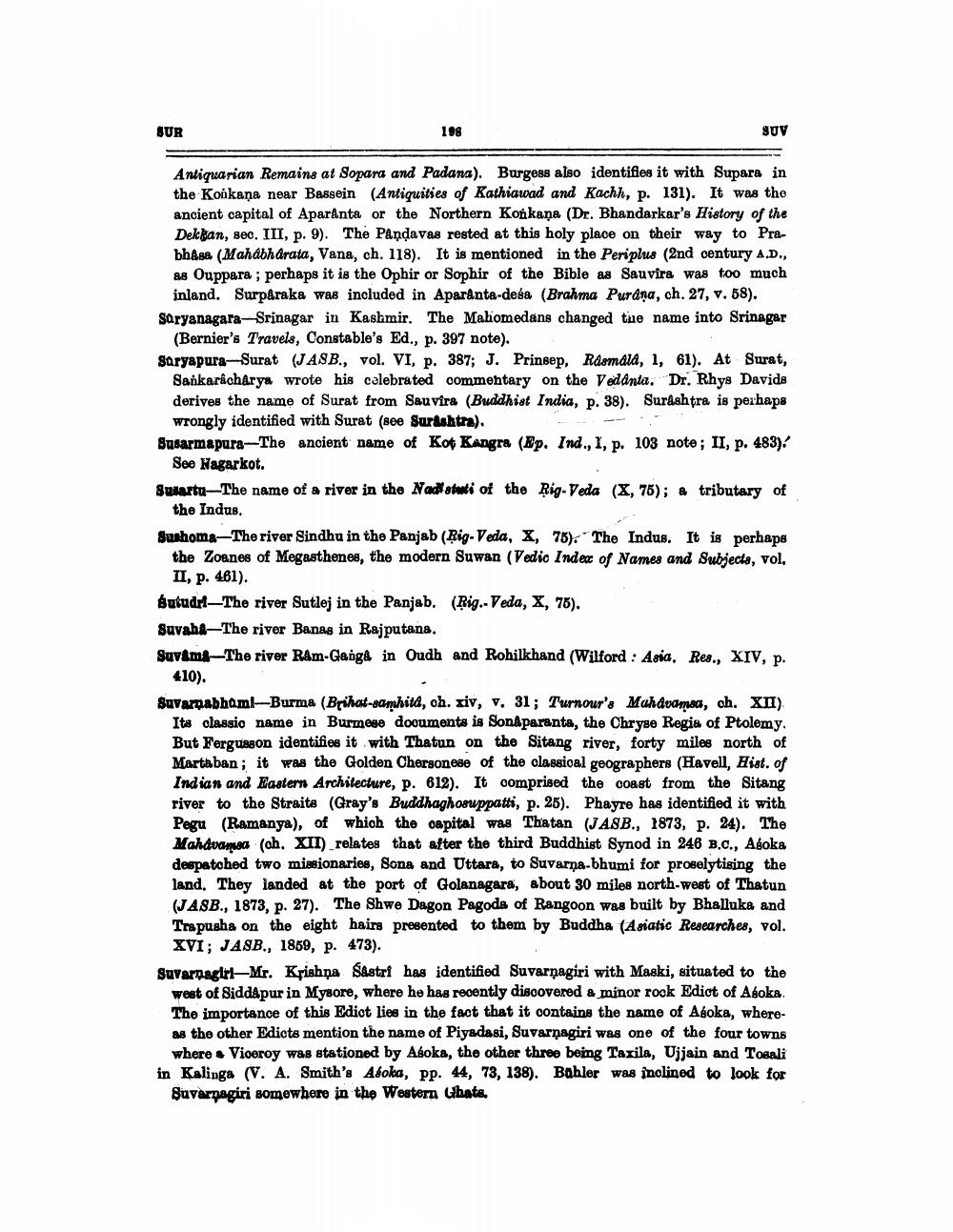________________
SUR
108
SUV
Antiquarian Remains at Sopara and Padana). Burgess also identifies it with Supara in the Konkana near Bassein (Antiquities of Kathiawad and Kach, p. 131). It was the ancient capital of Aparanta or the Northern Konkana (Dr. Bhandarkar's History of the Dekkan, sec. III, p. 9). The Pandavas rested at this holy place on their way to Prabhasa (Mahabharata, Vana, ch. 118). It is mentioned in the Periplus (2nd century A.D., As Ouppara; perhaps it is the Ophir or Sophir of the Bible as Sauvira was too much
inland. Surpäraka was included in Aparanta-desa (Brahma Purana, ch. 27, v. 58). saryanagara-Srinagar in Kashmir. The Mahomedans changed the name into Srinagar
(Bernier's Travels, Constable's Ed., p. 397 note). Saryapura Surat (JASB., vol. VI, p. 387; J. Prinsep. Raamaia, 1, 61). At Surat,
Sankaracharya wrote his celebrated commentary on the Vedanta, Dr. Rhys Davids derives the name of Surat from Sauvira (Buddhist India, p. 38). Surashtra is perhaps
wrongly identified with Surat (see Surasktra). Susarmapura-The ancient name of Kot Kangra (Ep. Ind., 1, p. 103 note; II, p. 483)!
See Nagarkot. Swartu-The name of a river in the Nadstuti of the Rig Veda (X, 75); a tributary of
the Indus. Sushoma-The river Sindhu in the Panjab (Rig Veda, x, 76). The Indus. It is perhaps
the Zoanes of Megasthenes, the modern Suwan (Vedic Index of Names and Subjects, vol.
II, p. 461). butuda-The river Sutlej in the Panjab. (Rig.- Veda, X, 76). Suvahd-The river Banas in Rajputana. Suvam -The river RAm-Gange in Oudh and Rohilkhand (Wilford : Asia. Res., XIV, p.
410). Suvarnabham-Burma (Brihat-camhita, oh. xiv, v. 31; Turnour's Mahavamsa, ch. XII)
Its classic name in Burmese documents is Son¶nta, the Chryse Regia of Ptolemy, But Fergusson identifies it with Thatun on the Sitang river, forty miles north of Martaban; it was the Golden Chersonese of the classioal geographers (Havell, Hist. of Indian and Eastern Architecture, p. 612). It comprised the coast from the Sitang river to the Straits (Gray's Buddhaghosuppatti, p. 25). Phayre has identified it with Pegu (Ramanya), of which the capital was Thatan (JASB., 1873, p. 24). The Mahdoamsa (ch, XII) relates that after the third Buddhist Synod in 246 B.C., Agoka despatched two miasionaries, Sona and Uttara, to Suvarna-bhumi for proselytising the land. They landed at the port of Golanagara, about 30 miles north-west of Thatun (JASB., 1873, p. 27). The Shwe Dagon Pagoda of Rangoon was built by Bhalluka and Trapusha on the eight hairs presented to them by Buddha (Asiatic Researches, vol.
XVI; JASB., 1869, p. 473). Suvarnagiri-Mr. Krishna Sastri has identified Suvarnagiri with Maski, situated to the
west of Siddapur in Mysore, where he has recently discovered a minor rock Edict of Asoka. The importance of this Edict lies in the fact that it contains the name of Asoka, whereas the other Edicts mention the name of Piyadasi, Suvarnagiri was one of the four towns
where - Viceroy was stationed by Asoka, the other three being Tazila, Ujjain and Tosali in Kalinga (V. A. Smith's Asoka, pp. 44, 73, 138). Bahler was inclined to look for
Suvarnagiri somewhere in the Western Ghats,




